
by Heidi Copeland | Apr 7, 2021

Carrots
Photo source: Heidi Copeland
According to industry standards, some of these carrots could not be sold because of “Serious damage” or any defect which seriously affects the general appearance of the
carrots in the container.
Waste less, save money is a great creed to live by. Really, it is that simple. One excellent example of this is food. Research indicates that 40% of all food in America is wasted yet, one in eight Americans does not have enough access to affordable, nutritious food. In other words, they are “food insecure.”
Wasted food is a MASSIVE problem at the commercial, institutional and residential levels. In fact, the Environmental Protection Agency (EPA) estimates there is more food than any other single material in our everyday trash and that approximately one-third of all food produced for human consumption worldwide is lost or wasted. In fact, in 2015, the USDA joined with the U.S. Environmental Protection Agency to set a goal to cut our nation’s food waste by 50 percent by the year 2030.
The sad fact is, most people do not realize how much impact food and food waste has on the earth and its issues of sustainability. Food waste occurs at every level of involvement. Examples of food waste include growing, processing (by-products too), transporting, point of sale, plate waste and uneaten prepared foods, and kitchen trimmings and their eventual disposal. Preventing food waste at all these levels can make a difference in addressing this issue.
However, preventing food waste it is not as easy as it seems. Many consumer factors also contribute to the problem.
- Food date labels confuse people. Use by/sell by dates are not always about food safety but about peak quality. Many foods are still safe to eat after their dates. Inspect “expired” foods closely via sight and smell before consuming – find ways to use up food past its prime.
- Households overbuy – do you really need super sizes? Buying in bulk is not always less expensive if much of it is discarded. Only purchase what you know you will use and do not get lured in by the “more for less” deals.
- Massive portions are often served – share or learn to love leftovers. Split enormous portions into multiple meals.
- Grocery stores overstock their shelves to maintain an image of abundance.
- People demand “perfect” produce. Farmers have a hard time selling less than stellar items. “Ugly” fruits and vegetables are just as delicious and nutritious as their more photogenic counterparts. Places such as farmers’ markets and community gardens are good places to find imperfect produce that would otherwise go to waste.
This Earth Day, (an event first celebrated on April 22, 1970 in the United States and is now a globally coordinated event in more than 193 countries) commit yourself to taking an action. As the late Neil Armstrong famously quoted as he stepped on to the moon… “This is one small step for a man, one giant leap for mankind!” If each of us considered and implemented our own practical or creative approaches to preventing food from going to waste what would our collective actions mean for mankind?
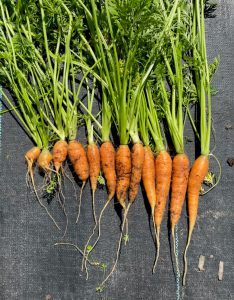
Fresh Carrots
Photo Source: Heidi Copeland
The best way to reduce food loss at home is not to create it in the first place. Not only would we individually save money, our collective efforts could conserve resources for future generations. The best method is the one you use.
- Reduce wasted food – shop smart, plan what you purchase, and use it, ALL of it!
- Maximize the efficiency of your refrigerator based on science. Read your refrigerator manual to learn where the coldest spots in the refrigerator are and what foods benefit from refrigerator location.
- Maximize the efficacy of canned products… use the FIFO (first in first out) method of rotation to use the oldest product before the newest on the shelf.
- Donate what you cannot use to others.
- Divert food scraps to animal food (chickens anyone?)
- Compost
- Landfill as the last resort.
Common causes of personal food waste include overbuying, over preparing and spoilage. The basic tenets of sustainability – reduce, reuse, recycle and refuse, work to reduce food waste too! Pay attention to purchases, eat what is prepared, store food properly, and refuse to waste. We can all do our part! Let’s start today.
https://savethefood.com/recipes/

by Julie McMillian | Jun 22, 2020

Today’s Climate
Photo Source: UF/IFAS Photo Database
Many confuse the two words climate and weather. Weather is the day to day conditions of our atmosphere. Whereas, climate refers to the average of the weather over time. Weather depicts how we dress day to day and can change often. Climate refers more to the average weather over time. We generally must prepare for our climate by buying appropriate clothing and preparing our home for longer term weather conditions.
What causes the climate to change? There are three important greenhouse gases that have dramatically increased since industrialization: carbon dioxide, nitrous oxide and methane. The increases are primarily due to our changes in land use over time. These factors make our earth’s surface temperature warmer which affects our loss of sea ice and longer fire seasons, and can contribute to extreme weather events.
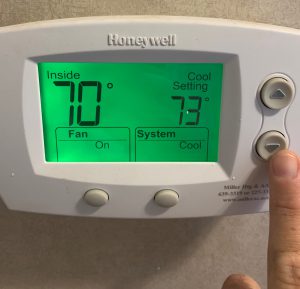
Adjust the temperature
Photo Source: Julie McMillian
The question is, what can I do in my own world and community to help on an individual basis? There are several ways that we can reduce our energy use of electricity at home which will help us to contribute to the bigger picture. Some simple suggestions are when you are not using the television, computer, lights, heating and cooling, try to turn them off or down for a while. Purchasing shades or curtains for your windows can keep your house cooler in the summer and fans may be able to replace the air conditioner on some occasions. When running the air, heat or hot water heater check your thermostat for energy saving features. Try to only run the dishwasher or washing machine with full loads and be sure to clean out your lint trap in the dryer so it has good airflow. You will find you might even save a few dollars by being mindful of your energy consumption.
Next, let’s talk about reducing greenhouse gases in our yards. Composting food scraps is a great way to reduce waste from landfills and turns your waste into reusable soil. Planting trees and plants helps to reduce carbon dioxide in the atmosphere. Plants store carbon and help to regulate temperatures in the home. Another thing to consider is, where does your water run off go? If water can be routed to your garden it is a win-win.
How do we plan our food system in our home? Reducing food waste has many benefits. We can save money, help our community, conserve energy and resources just by rethinking the way we plan our meals. If we buy more unprocessed foods, there will be less packaging. If we are able to grow our own food or just eat at home more, it cuts down on trips to restaurants and stores.
These are just a few ways to get you thinking about climate change in Florida. As a citizen, we can take action by staying informed and showing our support. If we hold ourselves accountable by looking at our personal impact, we may be surprised what we are leaving behind with our footprint. For more information on healthy living or other extension related topics, contact your local UF IFAS county extension office.
Supporting information for this article can be found in the UF/IFAS Extension EDIS publications:
Science Support for Climate Change Adaptation in South Florida
Climate Change Adaptation: New Perspectives for Natural Resources Management and Conservation
Energy Efficient Homes
UF/IFAS Extension is an Equal Opportunity Institution.
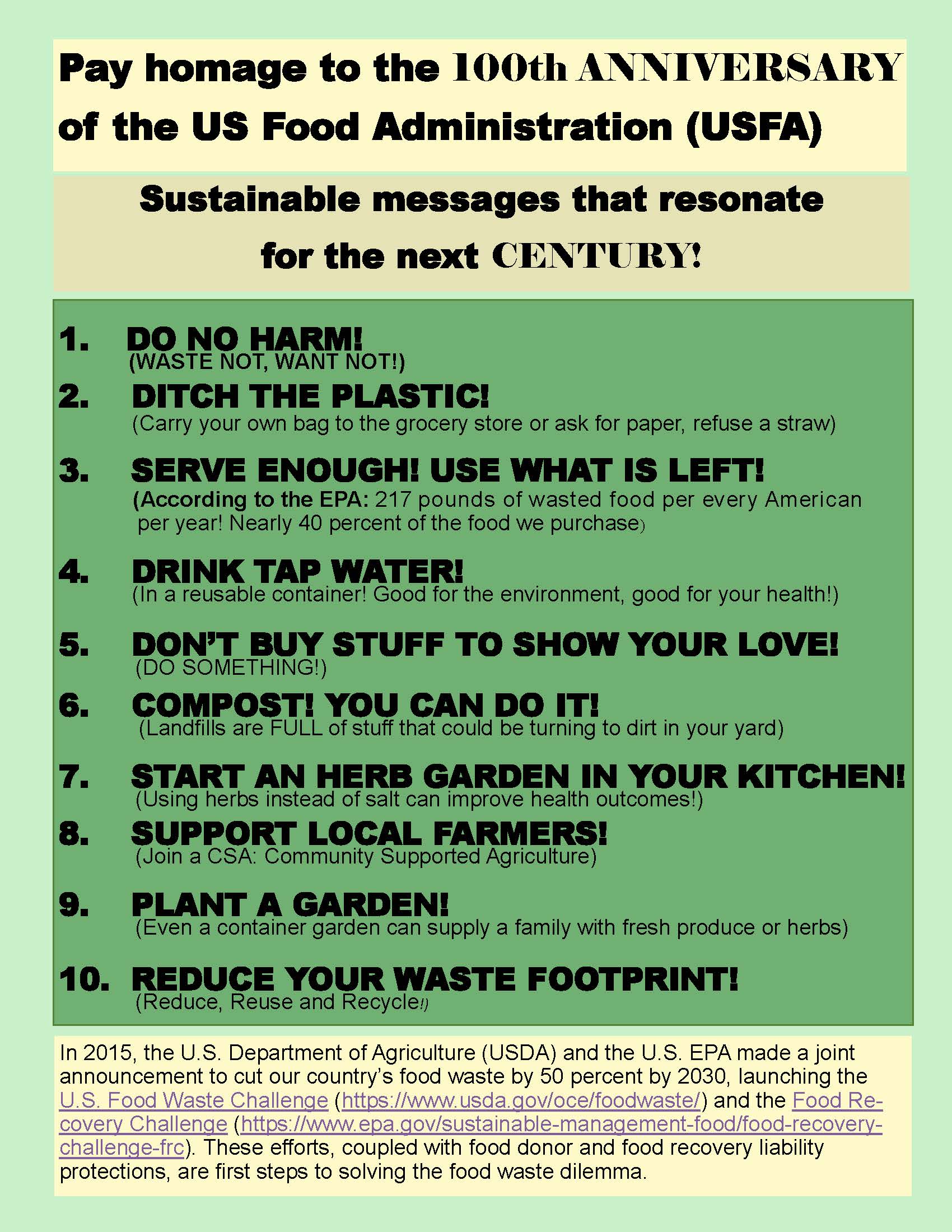
by Heidi Copeland | Mar 2, 2018
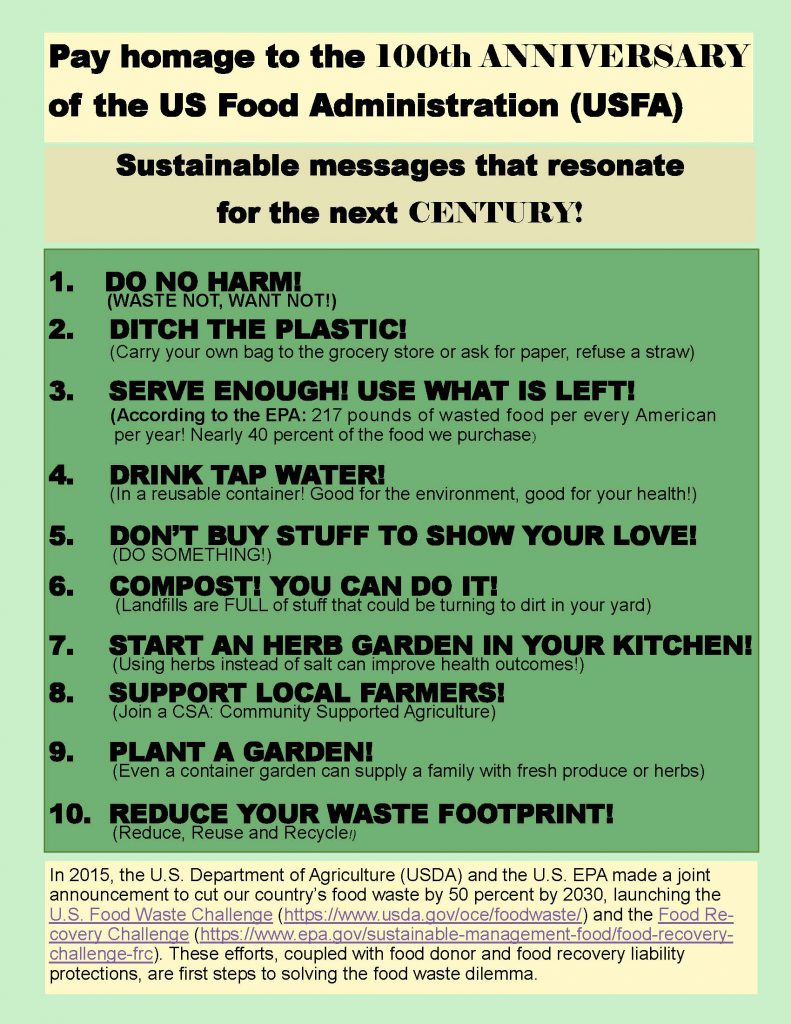
Photo credit: NW Extension District
Sustainability!
According to the Environmental Protection Agency (EPA), the term sustainability has emerged because of significant concerns about the unintended social, environmental, and economic consequences of our world’s rapid growth. Sustainability is based on the simple principle: Everything we need for our survival and well-being depends, either directly or indirectly, on our natural environment. Therefore, sustainability creates and maintains the conditions under which humans and nature can exist in harmony, fulfilling the social, economic, and other requirements of present and future generations.
WHEW! A mouthful, to be sure. Nevertheless, issues of sustainability are often overlooked on the individual level.
Did you know that during the United States’ (US) participation in World War I (from 1917 – 1918), the US had a US Food Administration (USFA) agency? This agency was responsible for food distribution to the US Army overseas and the Allies’ food reserves. This agency also organized a campaign to encourage Americans to support this effort through individual food conservation messages, media campaigns, and food education programs.
Now, 100 years later, this food conservation effort is still applicable.
Everyone can do his or her part in combating waste of all kinds. According to the USDA, reducing consumer-level loss is an important step toward reducing food waste in the United States. USDA estimates that almost 30 percent of the available U.S. food supply was lost from human consumption at the retail and consumer levels.
Every one of us can promote practices to strengthen our natural environment and quality of life. Even the EPA has some suggestions for reducing personal food waste:
- Shop your refrigerator first! Cook or eat what you already have at home before buying more.
- Plan your menu before you go shopping and buy only those things on your menu.
- Buy only what you realistically need and will use. Buying in bulk only saves money if you are able to use the food before it spoils.
- Be creative! If safe and healthy, use the edible parts of food that you normally do not eat. For example, stale bread can be used to make croutons and beet tops can be sautéed for a delicious side dish.
- Freeze, preserve, or can surplus fruits and vegetables – especially abundant seasonal produce.
- At restaurants, order only what you can finish by asking about portion sizes and be aware of side dishes included with entrees. Take home the leftovers and keep them for your next meal.
- At all-you-can-eat buffets, take only what you can eat.
Reducing food waste – a simple action of sustainability. Let’s give it a try! And pay homage to this 100-year-old sustainability campaign that can resonate for the next century.
For more information, visit https://www.usda.gov/oce/foodwaste/resources/consumers.htm and
http://edis.ifas.ufl.edu/fy1134
by Heidi Copeland | Apr 3, 2017
Earth Day: an issue of sustainability!
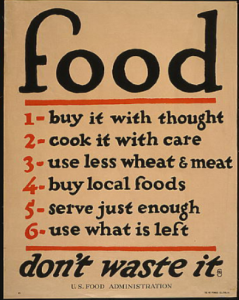 Have you ever thought about Earth Day, you know, that one day a year that falls on April 22nd?
Have you ever thought about Earth Day, you know, that one day a year that falls on April 22nd?
Earth Day was founded in 1970 by Gaylord Nelson, a U.S. Senator from Wisconsin, and sought to focus on the environment and how we can create healthy and sustainable surroundings. Almost a half-century later, the principals of Earth Day remain the same, and we continue to come up with ways to preserve, or make our environment a sustainable one.
As a consumer, what can we do to practice environmental sustainability?
We have many opportunities, Take food for instance. As a nation not only are we becoming super-sized but so is our food-related waste.
In August of 2012, the Natural Resources Defense Council (NRDC) issued a paper explaining that America Is Losing Up to 40 Percent of Its Food from Farm to Fork to Landfill. Yes, that is right; nearly 40 percent of our food supply is wasted (yet, one in eight Americans struggles to put food on the table).
The reasons for such waste are multifaceted; however, consumers are a major contributor to the problem. Key findings include:
The average American family of four ends up throwing away an equivalent of up to $2,275 annually in food.
In average American households, 2/3 of household waste is due to food spoilage:
40 percent of fresh fish
23 percent of eggs
20 percent of milk
Citrus fruits and cherries top the list for fruits, and sweet potatoes, onions, and greens are commonly wasted vegetables
Other household waste includes:
cooking too much
serving too much
over purchasing
plate waste
holiday celebrations
Wasted food also translates into wasted natural resources. It takes energy, water and farmland to grow, transport, and store food. Additionally, food waste is the single largest component of solid waste in U.S. landfills. By wasting less food, each of us can be an essential component in solving this increasing problem.
In 1917, the U.S. Food Administration distributed war effort posters in hopes of convincing the public to conserve food resources with expectations that this campaign would maintain an adequate supply of food for the troops fighting wars as well as for American households.
These century old practices are applicable today.
- Buy it with thought! We can be mindless in the way we purchase food in much the same way we can be mindless in how we eat our food. Make thoughtful purchases, as wise choices are better for both our planet and our body.
- Cook it with care. In the end, checking items we have on hand, planning menus and shopping with care makes us mindful and aware.
- Use less wheat & meat. In fact, Meatless Mondays was a sustainable war effort too! Practicing this use less effort provokes mindful eating of resource intense products.
- Buy local. Hardly a buzzword, the idea has been around for a long time. By mindfully purchasing local products, we are not stuffing items into our grocery carts without reflection on where the food comes from.
- Serve just enough. Choose My Plate, https://www.choosemyplate.gov/MyPlate gives a great visual representation of the foods each of us need on our plate. Not only can serving enough help our wallet, but it can help our waistline!
- Use what is left. Using what we have is a wise use of resources for both Mother Nature, personal finances and our health. Try eating your leftovers instead of throwing them into the landfill.
Norman Vincent Peale says, Change your thoughts and you change your world. Can the same thinking apply to our behavior? If each and every one of us made a small behavior change it could help change the world and make us better stewards of our environment, not just on April 22nd, but every day.
FOR MORE INFORMATION:
https://www.nrdc.org/issues/food-waste
http://www.nrdc.org/living/eatingwell/saving-leftovers-saves-money-resources.asp
by Dorothy C. Lee | Nov 25, 2016
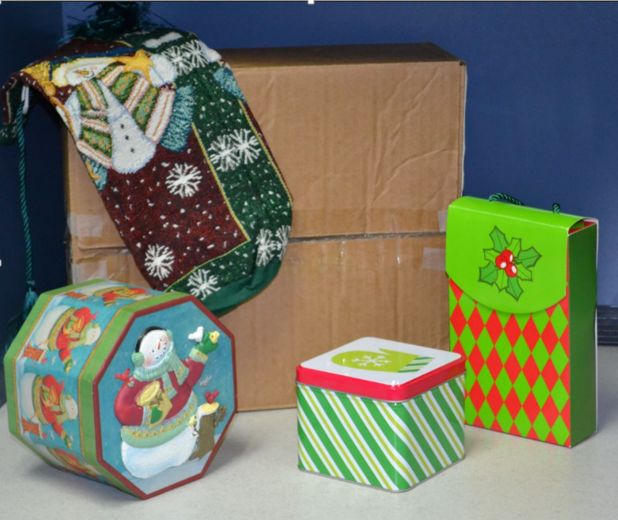 During the holiday season nothing carries good cheer and holiday spirit across the miles like receiving a package full of homemade treats.
During the holiday season nothing carries good cheer and holiday spirit across the miles like receiving a package full of homemade treats.
If you go to the effort of preparing food gifts, you want to be sure the contents arrive in the condition they were sent in. The first step is to pack it right.
- Select a strong sturdy cardboard, plastic, or metal container. Round oatmeal boxes or coffee cans with re-closable lids work well.
- On the bottom of the container place a generous layer of filler, such as crumped tissue paper, waxed paper, brown paper bags or plastic bubble wrap.
- Next, wrap baked goods individually or in pairs placed back to back. Begin with the sturdiest first. Moist, firm baked goods ship better than the brittle kind. Brownies, fudge and moist cookies pack well. Top with another layer of filler and repeat ending with a thick layer of filler.
- Fill the container full so the contents can’t shift when it is shaken.
- Be sure to pack several inches of cushioning material in the bottom of the shipping carton and enough material around, over and between items so that the contents cannot move easily. Brown paper bags and newspaper provide adequate cushioning for most packages. Save Styrofoam peanuts or foam packing pieces in packages for use when cushioning your packages.
- Place a card with the address of the sender and the receiver inside the carton, just in case.
- Wrap the carton in heavy brown paper, if desired, and seal it securely with transparent packing tape. Clearly label the carton; put the transparent tape over the address to keep it from getting wet and smeared. Mark it “perishable” to encourage careful handling. One of the best ideas yet is to give a gift within a gift that serves as its own alternative wrapping. Great tasting recipes become even more special when attractively packaged for giving.
- Embellish small metal coffee tins for packaging tiny truffles or other candies. Replace plastic tops to seal.
- Consider using an empty potato chip canister for packaging. Cover it with Christmas wrapping paper, fill it with cookies, candies or salty snacks, and replace its plastic top to seal.
- Fill a Christmas stocking with a favorite snack mix or nut mix. Package the mix in a re-sealable plastic bag and tuck it and holiday napkins into the stocking.
- Top off decorative jars of homemade desert sauces or jelly with raffia or decorative ribbon. Attach a homemade gift tag and a spoon.
- Bake and transport homemade bread in light weight recyclable aluminum pans available at most supermarkets. Wrap pans of bread with a large linen napkin or place bread in gift bags and tie with holiday ribbon.
- When giving a variety of foods together, include items to be eaten with your goodies or utensils that might be needed for further preparation.
Remember it’s the thought behind the holiday package that counts; the link with loved ones and the knowledge that someone is thinking of you during the holiday season. A package filled with homemade treats says “love” with every bite.










